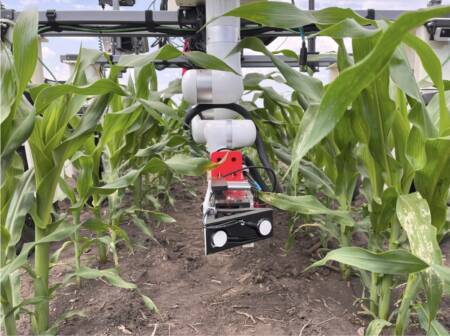
The robot arm autonomously identifies an optimal stalk and follows a motion sequence to position the stalk inside the gripper.
Corn is one of the most essential ingredients in global industry and agriculture. From tortillas, to ethanol, to starch, to alcohol, the plant remains a pillar in several production processes. Measuring the vitality and nutrient density of corn has become crucial to maintaining the efficiency and scale at which we utilize corn in our everyday lives, but can be a lengthy and time-consuming process.
Researchers at Carnegie Mellon University and Iowa State University created an agricultural robot platform to address these challenges. Led by George Kantor, Oliver Kroemer, and Mark Lee, the project enables robots to autonomously insert nitrate sensors into corn stalks and monitor macronutrient levels in the crops.
Inserting sensors into corn stalks requires a great amount of precision in environments that are often filled with unpredictable obstacles such as natural clutter and uneven terrain. In order to address these challenges, the team developed a robust “perception-action pipeline”. This pipeline employs a deep neural network to detect and identify the corn stalk with the highest likelihood of grasp success rate. The robot then uses a custom gripper which mechanically aligns the sensor with the stalk before inserting it into the plant.
The team designed the robot platform with easily configurable dimensions so that the robot can adjust to the unique row spacing and height of each field. They aimed to insert sensors into the plants during early stages of the plant cycle, since this early stage yields the most valuable data. These mechanisms worked alongside the nitrate sensor developed by the collaborators at Iowa State University.
The robot was deployed in Curtiss Farm in Ames, Iowa in July 2023, with high success rates in stalk detection, stalk grasping and sensor insertion. With an improved autonomy stack to include navigation and with a revamped gripper design, researchers from the lab are looking forward to deploying the robot in Iowa again this year.
The paper on autonomous crop monitoring was accepted into the IEEE Robotics Automation and Letters and the team will present their work at the 2024 IEEE/RSJ International Conference on Intelligent Robots and Systems (IROS) in October.
This research is open-sourced, with all information available on the project homepage.
For More Information: Aaron Aupperlee | 412-268-9068 | aaupperlee@cmu.edu